steering Citroen C4 PICASSO RHD 2012 1.G Owner's Guide
[x] Cancel search | Manufacturer: CITROEN, Model Year: 2012, Model line: C4 PICASSO RHD, Model: Citroen C4 PICASSO RHD 2012 1.GPages: 352, PDF Size: 9.91 MB
Page 166 of 352

IX
164
DRIVING
CRUISE CONTROL
System which automatically main-
tains the vehicle speed programmed
by the driver, without any action on
the accelerator pedal.
The cruise control is switched on
manually: the vehicle speed must
be at least 25 mph (approximately
40 km/h) and you must engage:
- fourth gear on a manual gearbox,
- second gear, in manual mode,
on an electronic or automatic
gearbox,
- position A
on an electronic gear-
box or D
on an automatic gearbox.
Steering mounted controls
The cruise control switches are lo-
cated on the left-hand side of the
steering wheel. The programmed information is
grouped together in zone A
of the
instrument panel screen.
Displays in the instrument
panel
Activation
You can then release the accelerator
pedal. The vehicle will automatically
keep to the speed chosen.
The speed of your vehicle may vary
slightly in relation to that memo-
rised.
You can adjust the memorised speed
in the instrument panel screen by
pressing:
�)
button 4
to increase the speed,
�)
button 2
to decrease the speed.
Successive presses modify the
cruise speed in steps of 1 mph
(1 km/h) and a sustained press in
steps of 3 mph (5 km/h).
Deactivation
�)
Either by pressing the brake or
the clutch pedal.
�)
Or by pressing button 3
.
�)
Or if either the ESP or the ASR
system is active.
The cruise control is not active if the
gear lever is in neutral. On selection of the
function via control 1,
no cruise speed has
yet been memorised.
Programming
Rotate the control 1
to the "REG"
position.
Once the desired speed has been
reached using the accelerator, press
button 2
or 4
. The cruise speed is
then memorised. It is displayed in
zone A
of the instrument panel. These actions cause
the information "OFF"
to appear in the instru-
ment panel screen.
These actions do not
cancel the cruise speed
which remains displayed in the instrument panel.
The cruise control cannot, in any circum-
stances, take the place of the obser-
vance of speed limits or of the vigilance
and responsibility of the driver.
Page 179 of 352
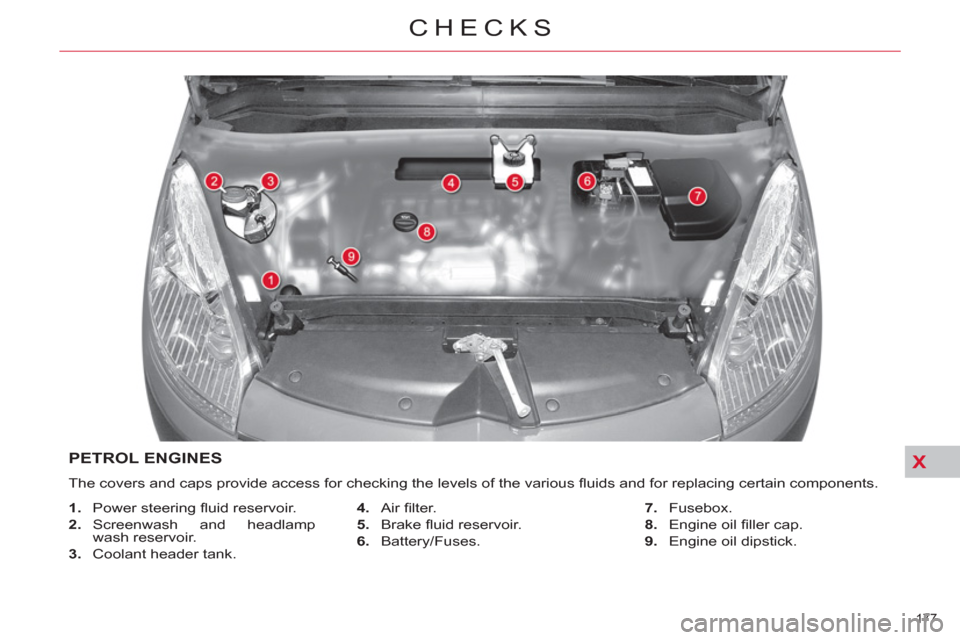
X
177
CHECKS
PETROL ENGINES
The covers and caps provide access for checking the levels of the various fl uids and for replacing certain components.
1.
Power steering fl uid reservoir.
2.
Screenwash and headlamp
wash reservoir.
3.
Coolant header tank.
4.
Air fi lter.
5.
Brake fl uid reservoir.
6.
Battery/Fuses.
7.
Fusebox.
8.
Engine oil fi ller cap.
9.
Engine oil dipstick.
Page 180 of 352

X
178
CHECKS
*
According to engine.
DIESEL ENGINES
The covers and caps provide access for checking the levels of the various fl uids, for replacing certain components and
for priming the fuel system.
1.
Power steering fl uid reservoir.
2.
Screenwash and headlamp
wash reservoir.
3.
Coolant header tank
4.
Brake fl uid reservoir.
5.
Battery/Fuses.
6.
Fusebox.
7.
Air fi lter.
8.
Engine oil fi ller cap.
9.
Engine oil dipstick.
10.
Priming pump * .
11 .
Bleed screw * . As the Diesel fuel system
is pressurised, any work on
this system is prohibited.
Page 181 of 352
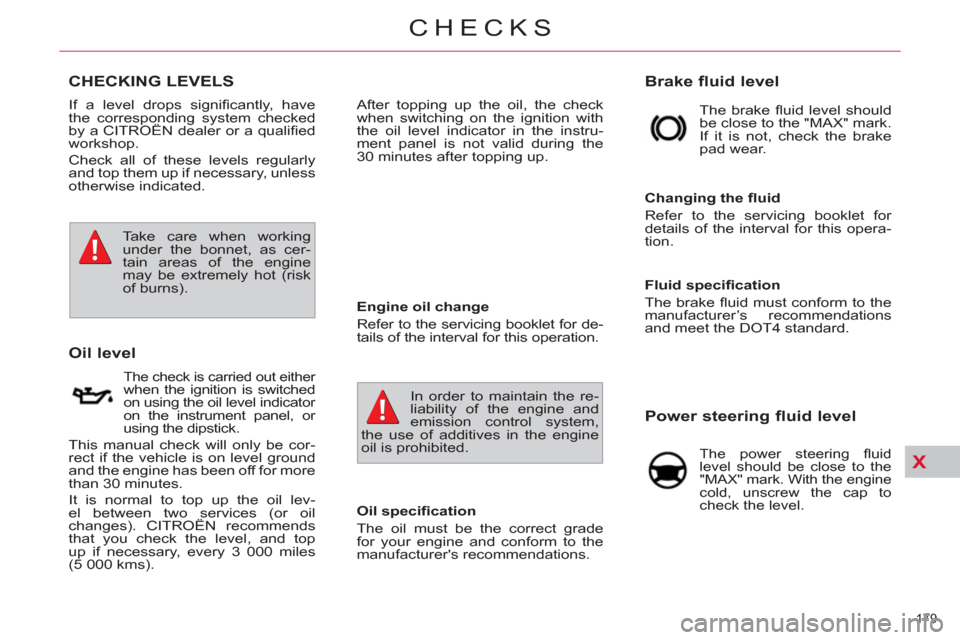
X
179
CHECKS
CHECKING LEVELS
Oil level
Oil specifi cation
The oil must be the correct grade
for your engine and conform to the
manufacturer's recommendations.
Brake fluid level
Changing the fl uid
Refer to the servicing booklet for
details of the interval for this opera-
tion.
Fluid specifi cation
The brake fl uid must conform to the
manufacturer’s recommendations
and meet the DOT4 standard.
The check is carried out either when the ignition is switched
on using the oil level indicator
on the instrument panel, or
using the dipstick.
This manual check will only be cor-
rect if the vehicle is on level ground
and the engine has been off for more
than 30 minutes.
It is normal to top up the oil lev-
el between two services (or oil
changes). CITROËN recommends
that you check the level, and top
up if necessary, every 3 000 miles
(5 000 kms). The brake fl uid level should
be close to the "MAX" mark.
If it is not, check the brake
pad wear.
In order to maintain the re-
liability of the engine and
emission control system,
the use of additives in the engine
oil is prohibited.
Take care when working
under the bonnet, as cer-
tain areas of the engine
may be extremely hot (risk
of burns).
Power steering fluid level
The power steering fl uid
level should be close to the
"MAX" mark. With the engine
cold, unscrew the cap to
check the level.
If a level drops signifi cantly, have
the corresponding system checked
by a CITROËN dealer or a qualifi ed
workshop.
Check all of these levels regularly
and top them up if necessary, unless
otherwise indicated.
Engine oil change
Refer to the servicing booklet for de-
tails of the interval for this operation. After topping up the oil, the check
when switching on the ignition with
the oil level indicator in the instru-
ment panel is not valid during the
30 minutes after topping up.
Page 185 of 352
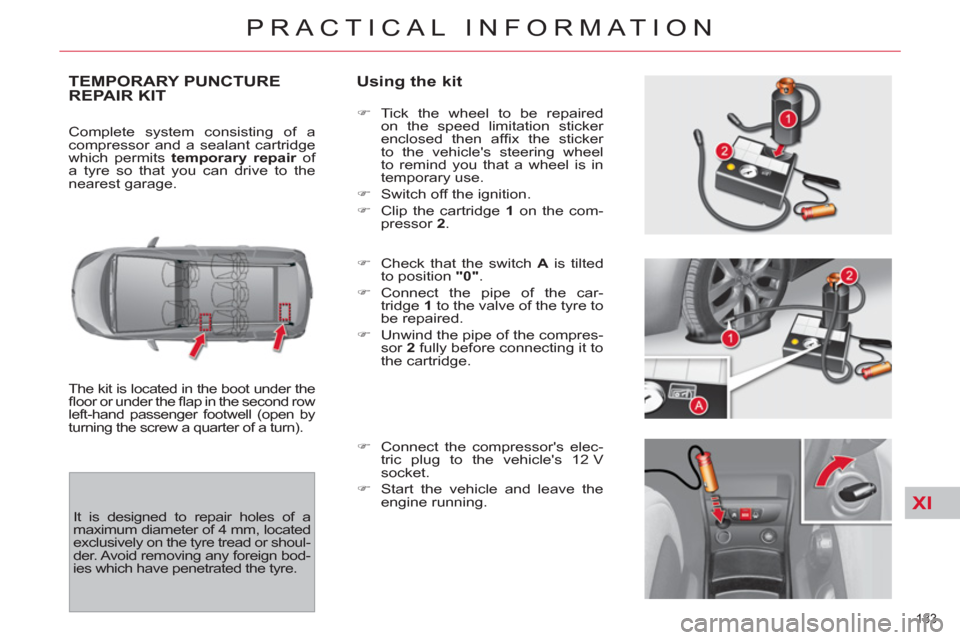
XI
183
PRACTICAL INFORMATION
TEMPORARY PUNCTURE
REPAIR KIT
Using the kit
The kit is located in the boot under the
fl oor or under the fl ap in the second row
left-hand passenger footwell (open by
turning the screw a quarter of a turn).
�)
Tick the wheel to be repaired
on the speed limitation sticker
enclosed then affi x the sticker
to the vehicle's steering wheel
to remind you that a wheel is in
temporary use.
�)
Switch off the ignition.
�)
Clip the cartridge 1
on the com-
pressor 2
.
�)
Check that the switch A
is tilted
to position "0"
.
�)
Connect the pipe of the car-
tridge 1
to the valve of the tyre to
be repaired.
�)
Unwind the pipe of the compres-
sor 2
fully before connecting it to
the cartridge.
�)
Connect the compressor's elec-
tric plug to the vehicle's 12 V
socket.
�)
Start the vehicle and leave the
engine running. Complete system consisting of a
compressor and a sealant cartridge
which permits temporary repair
of
a tyre so that you can drive to the
nearest garage.
It is designed to repair holes of a
maximum diameter of 4 mm, located
exclusively on the tyre tread or shoul-
der. Avoid removing any foreign bod-
ies which have penetrated the tyre.
Page 200 of 352
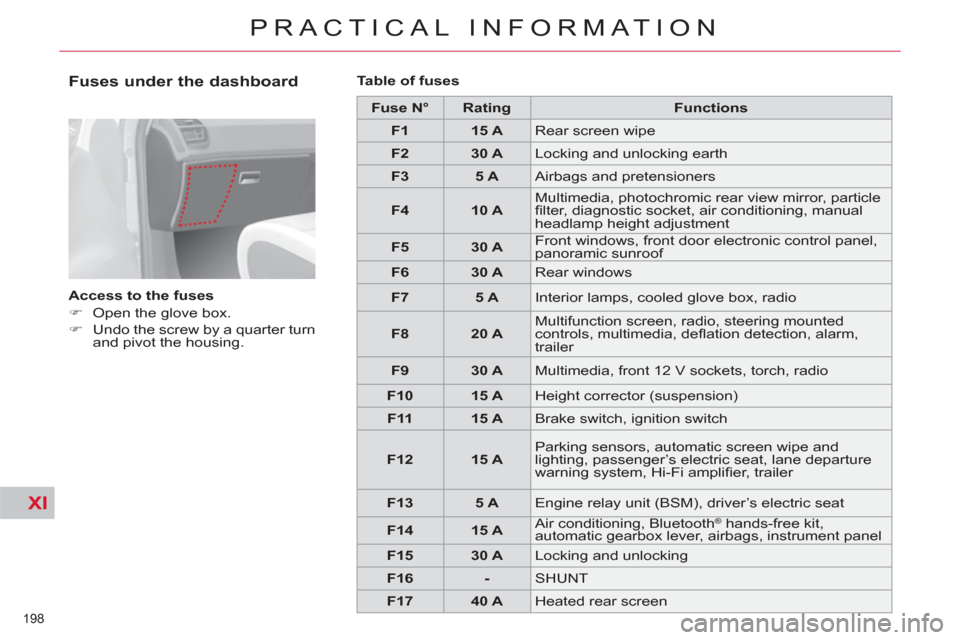
XI
198
PRACTICAL INFORMATION
Access to the fuses
�)
Open the glove box.
�)
Undo the screw by a quarter turn
and pivot the housing.
Table of fuses
Fuse N°
Rating
Functions
F1
15 A
Rear screen wipe
F2
30 A
Locking and unlocking earth
F3
5 A
Airbags and pretensioners
F4
10 A
Multimedia, photochromic rear view mirror, particle
fi lter, diagnostic socket, air conditioning, manual
headlamp height adjustment
F5
30 A
Front windows, front door electronic control panel,
panoramic sunroof
F6
30 A
Rear windows
F7
5 A
Interior lamps, cooled glove box, radio
F8
20 A
Multifunction screen, radio, steering mounted
controls, multimedia, defl ation detection, alarm,
trailer
F9
30 A
Multimedia, front 12 V sockets, torch, radio
F10
15 A
Height corrector (suspension)
F11
15 A
Brake switch, ignition switch
F12
15 A
Parking sensors, automatic screen wipe and
lighting, passenger’s electric seat, lane departure
warning system, Hi-Fi amplifi er, trailer
F13
5 A
Engine relay unit (BSM), driver’s electric seat
F14
15 A
Air conditioning, Bluetooth
®
hands-free kit,
automatic gearbox lever, airbags, instrument panel
F15
30 A
Locking and unlocking
F16
-
SHUNT
F17
40 A
Heated rear screen
Fuses under the dashboard
Page 203 of 352
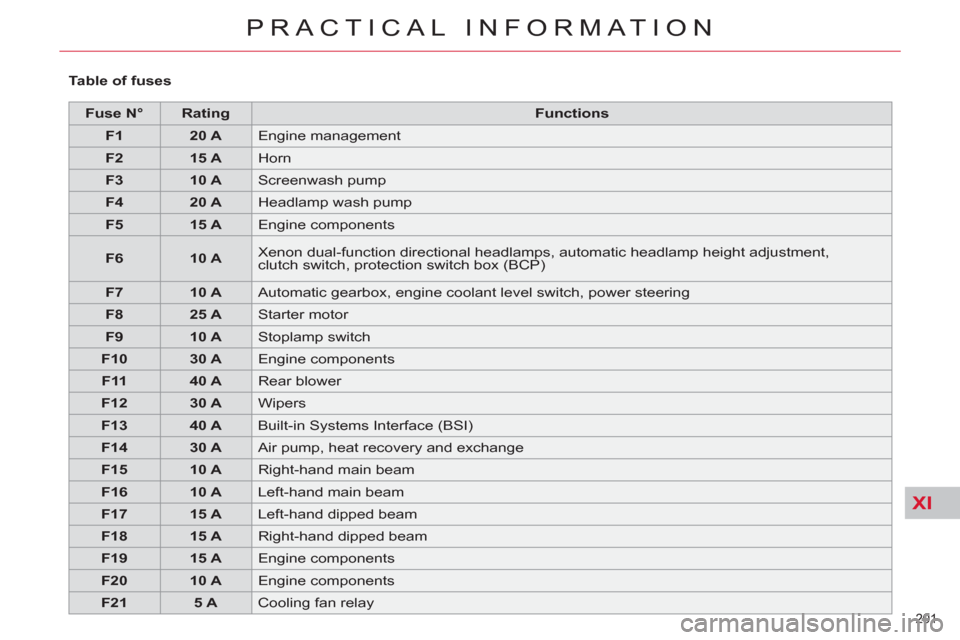
XI
201
PRACTICAL INFORMATION
Fuse N°
Rating
Functions
F1
20 A
Engine management
F2
15 A
Horn
F3
10 A
Screenwash pump
F4
20 A
Headlamp wash pump
F5
15 A
Engine components
F6
10 A
Xenon dual-function directional headlamps, automatic headlamp height adjustment,
clutch switch, protection switch box (BCP)
F7
10 A
Automatic gearbox, engine coolant level switch, power steering
F8
25 A
Starter motor
F9
10 A
Stoplamp switch
F10
30 A
Engine components
F11
40 A
Rear blower
F12
30 A
Wipers
F13
40 A
Built-in Systems Interface (BSI)
F14
30 A
Air pump, heat recovery and exchange
F15
10 A
Right-hand main beam
F16
10 A
Left-hand main beam
F17
15 A
Left-hand dipped beam
F18
15 A
Right-hand dipped beam
F19
15 A
Engine components
F20
10 A
Engine components
F21
5 A
Cooling fan relay
Table of fuses
Page 210 of 352

XI
208
PRACTICAL INFORMATION
General recommendations
Observe the legislation in force in your country.
Ensure that the weight of the towing vehicle is higher than that of the towed vehicle.
The driver must stay at the wheel of the towed vehicle.
Driving on motorways and fast roads is prohibited when towing.
When towing a vehicle with all four wheels on the ground, always use an approved towing bar; rope and straps are
prohibited.
When towing a vehicle with the engine off, there is no longer any power assistance for braking or steering.
In the following cases, you must always call on a professional recovery service:
- vehicle broken down on a motorway or fast road,
- when it is not possible to put the gearbox into neutral, unlock the steering, or release the parking brake,
- towing with only two wheels on the ground,
- where there is no approved towing bar available...
Page 233 of 352

231
NaviDrive
The NaviDrive is coded in such a way that it will onlyoperate in your vehicle.
For safet
y reasons, it is imperative that the driver carries
out operations which require prolonged attention while
the vehicle is stationary.
When the en
gine is switched off and to prevent
discharging of the battery, the NaviDrive may switch off after a few minutes.
MULTIMEDIA AUDIO/TELEPHONE SYSTEM
JUKEBOX FUNCTION (10 GB)/GPS (EUROPE)
01 First steps
02
Voice commands and
steering mounted controls
03 Screen and main menu
04 Navigation - Guidance
05 Traffic information
06 Audio/Video
07 Telephone
08 Configuration
09 Screen menu map
Frequently asked questions p.
p.
p.
p.
p.
p.
p.
p.
p.
p.
232
233
235
239
249
251
260
264
265
271
CONTENTS
Page 235 of 352

233
02
32
15
4
2
1
32
15
4
3
4
VOICE COMMANDS AND STEERING MOUNTED CONTROLS
1. Volume increase.
2. V
olume decrease.
3. Mute.
4. RADI
O:
selection o
f the previous or next storedstation.
MP
3/JUKEBOX:
selection of the previous or next director
y.
5. RADI
O: automatic search for a higher frequency.
CD/MP3/JUKEBOX:
selection of the next track.
CD/MP3:
continuous press: fast forwards pla
y.
1. Short press:
Activation o
f voice recognition.
2. WHEN THE TELEPH
ONE IS NOT IN USE:
Long press: access to the telephone menu
(phone book, call list, ...).
INCOMING CALL:
Short press to accept.
Long press to reject the call.
CALL IN PROGRESS:
Short press to hang up.
Long press to access the telephone menu.
3. Personalisation:
Short press: confi rmation of the selection
ma
de using the dial.
4. Rotation:
Move around the phone book, the call list.
Selection of personalisation.
1. Displa
ys the main screen.
2.
Selection of the mode displayed (TRIP, TEL,NAV or AUDIO).
3. Abandon the operation in progress
and return to the previous display.
4. Navi
gation through the menus.
5. Confi rmation of the function selected.